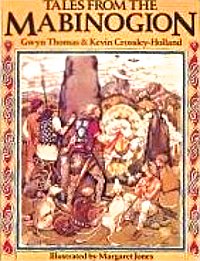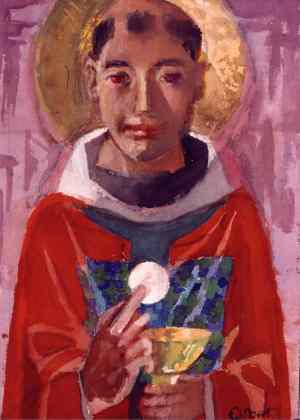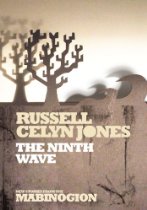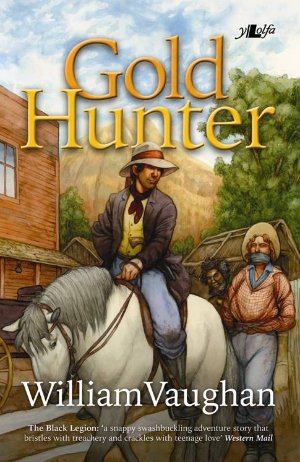Blogs
|
This could be called an illustrated Readers Digest of the Mabinogion. At 88 pages including illustrations, which are excellent, this is a small work. Some branches of the Mabinogion are done well if briefly, others are lacking. This collection of medieval Welsh tales was selected from the Mabinogion myth cycle. They serve as great examples of the old stories of the Celtic Gods who lived on the Island of the Mighty before the Romans and the Anglo-Saxons came. These gods were pushed into mythic status by the coming of Christianity and they live on in these tales. With vibrant Welsh names like Branwen, Bendigeidfran, and Cigfa, these male and female heroes of yesteryear encounter beautiful enchantresses, powerful kings of the underworld, and the magical cauldron of rebirth. These are powerful tales of an ancient time when giants roamed the earth and magic was afoot. They rely on familiar folk tale archetypes, but have distinctly Celtic elements that make them unique. The book was originally written for adults, and it includes stunning illustrations that include an artistically rendered nude image of a woman, but the tales themselves are accessible to readers and listeners of all ages. This book would be a good addition to any folk tale collection. Purchase here:- Tales From The Mabinogion Paperback: 88 pages Rating: 5 Stars Review by Bill Tillman
|
Pope Benedict XVI wishes every success to the Mass in honour of Saint John Roberts in Cymer Abbey
By Ceri Shaw, 2010-05-13
| This promises to be a very moving and emotional tribute, says Archbishop Peter Smith, the Archbishop of Cardiff. Its a sad but undeniable truism that a genuine prophet is hardly ever honoured in his own country but Im hoping that this magnificent Mass will help make St John Roberts as famous in his native Wales as he is in countries like France and Spain. St John Roberts was born at Rhiw Goch farm near Trawsfynydd and it is believed that he received his early education from a monk at Cymer Abbey before moving to Oxford to study Law. On the completion of his studies he travelled to France and it was here that he converted to Catholicism. He moved to Valladolid in Spain where he trained as a Priest, and returned to London to care for the poor but was exiled many times by the anti-catholic authorities before eventually being sentenced to death in Tyburn on December 10th, 1610. He was canonised by Pope Paul VI in 1970. 'Cymer Abbey is such a perfect location to commemorate the martyrdom of St John Roberts, said Lord Dafydd Elis Thomas, Presiding Officer of the Welsh Assembly. This was one of the many institutions of the Order of the Cistercians which received so much support during the days of the Welsh princes from Llywelyn the 1st and 2nd. They helped develop fishing and sheep farming in Meirionydd and their eventual downfall was a major blow, both in spiritual and social terms. It was St John Roberts conversion to Catholicism which led to his being created the first prior of the Benedictine college St Gregory and the orders first martyr in Britain four centuries ago. Three choirs St Josephs Schola from Pwllheli, the Wrexham Diocesan Choir and the Newcastle Emlyn Choir - will be present under the musical supervision of Gillian Williams FRCO and, in addition, the Mass will attract a distinguished ecclesiastical presence including Monsignor Brian Udaigwe - First Consellor to the Apostolic Nuncio, who will be making a special journey from the Vatican to represent His Holiness Pope Benedict XVI. On behalf of His Holiness Pope Benedict, Monsignor Brian Udaigwe, First Counsellor to the Apostolic Nuncio, wishes every success to the Mass in honour of St John Roberts in Cymer Abbey on 6th June, 2010. Monsignor Brian will be representing the Papal Nuncio, Archbishop Faustino Sainz Munoz at the Mass. We are delighted that the Apostolic Nuncio to Great Britain will be represented at the celebration by Monsignor Brian Udaigwe, First Consellor to the Papal Nuncio, says Archbishop Peter Smith, this will be a very special ecumenical occasion in which we will be able to celebrate the life and sacrifice of a very remarkable man. For us in Dolgellau says the towns Member for Parliament Elfyn Llwyd, St John Roberts is more than a local hero- he was a national and, indeed- as the tremendous interest this event has inspired tends to suggest- an international hero too. I am looking forward to attending the Mass and honouring his memory. In recognition of St John Roberts period of study in Spain the Mass will welcome inhabitants of the city of Valladolid together with representatives of the Abbeys of Belmont and Downside of the Benedictine Congregation (St John Roberts founded Downside Abbey in 1605). Non-ecclesiastical dignitaries will include the Mayor of Dolgellau, the Chairperson of Gwynedd Council and numerous local dignitaries. It is also hoped that a 100 year old replica of the Cymer Abbey Chalice and Patten from the National Museum of Wales will be on display on the altar during the Mass. Following the open-air Mass St John Roberts will be further honoured between the 15th and 18th of July with a pilgrimage from Wales to London where- on the 10th of December 1610 - St John Roberts was martyred at Tyburn. The highlight of this pilgrimage will be a multi-faith service at Westminster Abbey on Saturday 17th July attended by the heads of all the Churches including The Archbishop of Canterbury, Rowan Williams and The Archbishop of Westminster, Vincent Nicholls. Both Archbishops will be addressing the event (Archbishop Rowan in Welsh and Archbishop Vincent in English) and all the Archbishops and Bishops of Wales, Catholic and Anglican, will be present. During the service, Lord Dafydd Elis Thomas will unveil a newly-commissioned mosaic of St David and the Most Reverend Peter Smith will host a reception after the service. By recognizing and celebrating our religious heritage, says Lord Dafydd Elis Thomas, we recognize also the unfortunate divisions and prejudices that lie within religions both in the past and in the present age. I am hopeful that we can come together in prayer and hope for greater understanding between communities and religious convictions- understanding which can benefit us all both today and well into the future.
Images of Cymer Abbey by Jeffrey L. Thomas |
David Western & Laura Gorun's Left Coast Eisteddfod Lovespoon Blog, 16 April 2010, "Re-Arranging Things"
By gaabi, 2010-05-11
My immediate thought when I saw Dave's drawing with the knotwork tied in with the eagle's tail was that the knotwork would make a lovely central part of the spoon. I share Dave's appreciation for the message that Celtic knotwork conveys - forever and Celtic heritage, among other things. Cymru am byth! (Wales forever!) Seems like a good central message for this spoon! I made several different drawings, arranging, re-arranging, changing sizes.... all sorts of things.
Here is where I arrived:;  I am still unsure about the top half- I like the idea of vinework wrapping around the flat frame-like part. I still was unsure of how I wanted to do flowers, or if we should even try a couple daffodils instead, but moving the knotwork into the middle would leave room at the top for Dave and I to do something together. Also, above the knotwork, I added a little twist that I seem to do in a lot of my designs. I thought it might be a good transition from Dave's style to mine. I also drew a couple simple vines, still tying the knot into the eagle's tail, and behind the frame, also into the wing. Before I went too far working on ideas for the top, though, I wanted Dave's thoughts about moving the knotwork into the middle. If he likes this, and doesn't miss the cirle in the middle too much, then we can work on the top part next. We'll see what Dave thinks...
I am still unsure about the top half- I like the idea of vinework wrapping around the flat frame-like part. I still was unsure of how I wanted to do flowers, or if we should even try a couple daffodils instead, but moving the knotwork into the middle would leave room at the top for Dave and I to do something together. Also, above the knotwork, I added a little twist that I seem to do in a lot of my designs. I thought it might be a good transition from Dave's style to mine. I also drew a couple simple vines, still tying the knot into the eagle's tail, and behind the frame, also into the wing. Before I went too far working on ideas for the top, though, I wanted Dave's thoughts about moving the knotwork into the middle. If he likes this, and doesn't miss the cirle in the middle too much, then we can work on the top part next. We'll see what Dave thinks...
- Laura
David Western & Laura Gorun's Left Coast Eisteddfod Lovespoon Blog, 13 April 2010, "Knots"
By gaabi, 2010-05-11
For anyone new to this, lovespoons are a traditional Welsh folk art. David Western and Laura Gorun are lovespoon carvers who have very generously donated their time to create a one-of-a-kind masterpiece in support of the Left Coast Eisteddfod, a Welsh performing arts festival for the west coast of North America. Every dollar you donate through the blog buys you a ticket and a chance to win the spoon. Five dollars, equals five tickets, fifty dollars equals fifty tickets and fifty chances to win. This is David's second year of creation in support of this event and we are very grateful for his and Laura's generosity in sharing their work with us all. For a chance to win their spoon this year, click on the donate button on the blog or in the right-hand column on this page under the Left Coast Eisteddfod Competitions button and be sure to note that your donation is for the lovespoon. Reprinted with permission from David Western's blog , all material 2010, David Western --
 Wow!! After going through Laura's flurry of excellent ideas, it looks like we will be spoiled for choices idea-wise!
Wow!! After going through Laura's flurry of excellent ideas, it looks like we will be spoiled for choices idea-wise!Any one of the drawings she has come up with could form the basis for a marvelous lovespoon design so I've photocopied them all and am looking to see which design elements jump out at me and which don't.
I am very drawn to the eagle Laura has drawn with its wing wrapped dramatically around the top section of the spoon. I love the idea of the eagle appearing in our design as it is the symbol of America and it will go nicely with the Welsh dragon. Since the spoon symbolizes the merging of cultures, the dragon and eagle are very logical symbols, but I'd like to figure out a way to merge Laura's more realistic looking eagle into some Celtic knotwork as I have done with the dragon.
I also feel there is a section above the central circle which feels a bit too 'light'. To give this section a bit more weight without having it become overwhelmingly heavy, I want to utilize a nice pattern of Celtic knotwork.
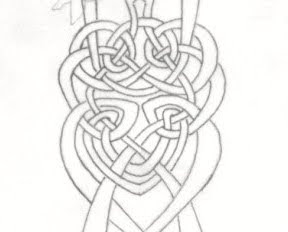 While Celtic knotwork is almost unheard of on historical lovespoon examples, it has been embraced by modern lovespoon carvers to represent the notion of eternity or eternal love. This is especially so when the knot is circular or is 'enclosed' with no beginning or ending to the knot. For our spoon, the notion of eternity as it relates to the emigration of the Welsh to North America is an apt one. the Welsh have been here since the earliest European arrivals and hopefully will remain here as long as there is a North America! I don't know if Laura feels as strongly about it as I do, but for me, things like this lovespoon and the Left Coast Eisteddfod it is being made in support of, vividly illustrate that despite being the 'forgotten Celts', the Welsh have made and continue to make vibrant contributions to North American culture. I should mention that this spoon is being designed and crafted to help raise funds for the Left Coast Eisteddfod which will be held in Portland, Oregon on October 03-10, 2010. This will be the second year for this annual event and an exciting combination of online cultural competitions and live events in Portland. Please visit: http://americymru.ning.com/page/the-left-coast-eisteddfod-2010 to learn more. Your donation to the Left Coast Eisteddfod will earn you a chance to win this spoon, so even if you don't want to enter the competitions, you could still win a very lovely prize!!
While Celtic knotwork is almost unheard of on historical lovespoon examples, it has been embraced by modern lovespoon carvers to represent the notion of eternity or eternal love. This is especially so when the knot is circular or is 'enclosed' with no beginning or ending to the knot. For our spoon, the notion of eternity as it relates to the emigration of the Welsh to North America is an apt one. the Welsh have been here since the earliest European arrivals and hopefully will remain here as long as there is a North America! I don't know if Laura feels as strongly about it as I do, but for me, things like this lovespoon and the Left Coast Eisteddfod it is being made in support of, vividly illustrate that despite being the 'forgotten Celts', the Welsh have made and continue to make vibrant contributions to North American culture. I should mention that this spoon is being designed and crafted to help raise funds for the Left Coast Eisteddfod which will be held in Portland, Oregon on October 03-10, 2010. This will be the second year for this annual event and an exciting combination of online cultural competitions and live events in Portland. Please visit: http://americymru.ning.com/page/the-left-coast-eisteddfod-2010 to learn more. Your donation to the Left Coast Eisteddfod will earn you a chance to win this spoon, so even if you don't want to enter the competitions, you could still win a very lovely prize!!  So, with a nice Celtic knot in mind, I selected Laura's eagle crowned spoon with its little cascade of flowers. The lower body of the eagle merges into the knotwork, but its upper body remains pretty realistic. I changed some of the framework around and utilized some of the bottom section of the frame to create the origin of the knot. The knotwork has nicely filled in some of the 'empty' spaces, but I now am not so happy about the central circle. Originally, I had hoped that it would become the focal area of the spoon, but I'm not so sure about it now. It will be interesting to hear Laura's views on whether or not she likes the knotwork and where she thinks we should go with it next!
So, with a nice Celtic knot in mind, I selected Laura's eagle crowned spoon with its little cascade of flowers. The lower body of the eagle merges into the knotwork, but its upper body remains pretty realistic. I changed some of the framework around and utilized some of the bottom section of the frame to create the origin of the knot. The knotwork has nicely filled in some of the 'empty' spaces, but I now am not so happy about the central circle. Originally, I had hoped that it would become the focal area of the spoon, but I'm not so sure about it now. It will be interesting to hear Laura's views on whether or not she likes the knotwork and where she thinks we should go with it next!-Dave
| Jeff Jones is a former Welsh amateur footballer; a Boys Clubs of Wales international in 1979. The same year he scored a hat-trick in the final of that seasons Welsh Youth cup final. During a long and undistinguished football career in the game he played in every position on the pitch and has occupied every position off the field of play from club chairman to programme editor. Park Life The Best Bits is a collection of the funniest articles from the RTB Ebbw Vale FC match programme edited by Jones, and despite the club being so far down the football pyramid they were almost on the Sphinx! Park Life proved an award winning match programme completing a hat-trick of Gwent County Programme of the year wins and was also voted best in its category (level 3 and below) 3 years running in the Welsh Football Magazines Programme of the year wards. Three times in its 6 year history the programme was named in the top 5 in Wales finishing 3rd Twice this in the overhaul category, beating programmes printed professionally by clubs playing at the highest levels of Welsh football. Park Life ran from 2003-2009 though Jones continues to write humorous articles in the Welsh Football Magazine on a monthly basis. Ebbw Vale, made famous by politician Aneurin Bevan can also boast Oasis manager Marcus Russell as famous sons, as well as former world number one snooker player Mark Williams and rugby internationals such as Clive Burgess and Ian Watkins. Jones used his match programme to share numerous stories of his struggles with football teams at the lower end of the football pyramid though also used an array of fictional characters to air their views on professional football at a world level, so there is something of interest for any football fan amongst the pages of his book. Contact details Email address: Jeff1961@btinternet.com Book ISBN number: 9781449073886 Check out the web site at www.jeffjonesbooks.co.uk
Park Life The Best Bits Includes
Never one to sit on the fence we at Park Life asked some well respected footballing figures to help sort out this mystery from yesteryear and having received no replies from anyone made the following ones up!
Ron Atkinson
Spotters badge Clive! For me it was handbags, the big fella should not have been anywhere near the wall, he should have been hanging around the back stick.
Ill tell you another thing for me Clive. The big fella went down far too
Kevin Keegan
I tell Ya...I, I When you say that about professional soldiers not being able to put him back together again. Were bigger than that I..I..Ive kept quiet for too long, but I tell Ya hes gone down in my estimation!
World Exclusive Interview Shep the Blue Peter Dog
I immediately became friends with Stan Bowles he passed me a ball and said hello show us your pedigree chum! With you in the side we can Winalot! Stan would bet on anything and one day he was playing keepy uppies and said there's nothing I cant do with a ball! I replied I bet you a tenner Ive a trick you cant do
Youre on mate he cried. So I sat down and licked mine and said you cant do this!
In off the post!
Letters Page
* With all this talk about a credit crunch why dont we all move to that place called jeopardy, because apparently there are
Yours Bryn Picca
* A man in the pub told me that Englands Theo Walcott is so young that he was not only awarded with a cap but also a satchel
Yours Barry Island
Touch! Ed
Film Night Wales
Stuck for a DVD to buy for Christmas? Check out these Welsh titles
Trefforest Gump The Lost BoyosAn American Werewolf in Llandudno Huw DaresWyns Dai Hard Evans Almighty Meet Dai Idris Jones and the temple of Dyfed The Wizard of Oswestry Treasure Barry Island The Eagle has Llangynidr The Golden Cwm by pass The Good the Balla and the Ugly Doctor Dai Little The Magnificent River Seven Haverfordwest Was Won Saving Private Ieaun Independence Dai The Welsh Connection The Bridge on the River Wye Lawrence of Snowdonia The Welsh Patient Ian Rush Hour The King and Ira Look Back in Bangor Dial M for Merthyr Dai another Day A Rhondda world in 80 Dais Caerphillydelphia Merthyr on the Orient Express Ponty Pythons Life of Bryn A Fishguard called Wanda Daddy Dai Camp Where Eagles Aberdare From Rassau with Love
|
| "You cannot be a true Mabinogi fan without reading this book " The Ninth Wave is a retelling of Pwyll, Lord of Dyfed from the First Branch of the Mabinogion. Jones paints a world in the future where planet earth is out of oil. The horse is the preferred mode of transportation, sailing ships rule the seas and centralized governments have failed. Cars, trucks & vans are all roadside relics many of which are now inhabited. Wales is ruled by cantrefs (like our counties), which are inherited or won by conquest. While this Mad Max setting is intriguing, it seems slightly unpolished or needing more thought and attention to detail to make it work. However, there is enough here to make an interesting tale as long suspend your disbelief and ignore the awkward parts of it. When Pwyll drives, his mint condition saved and stored Bentley convertible on a tour of sacrifice while using its last tank of gas. The climax being to drive into a lake on another Lords property as a peace offering, yes that is what I said! (Here my lip trembles) I got out my hanky, well I will spare the details just saying it ended up wet and snotty. I have sat on this review for some time now, hoping to gain a more unbiased view of the work. In rereading the original tale of Pwyll, you find a young Lord who meets the Lord of the Otherworld. He swaps places with him for a year and a day including total shape shift of bodies. Slays (only a human can kill a god) the only competing Lord of that realm. Kills the suitor of the woman he wants to marry, has a son, son is kidnapped, wife is blamed and punished. Son is restored as a teenager and Pwyll rules happily ever after. Briefly an awkward paced fast then slow tale, deserving more space for a retelling. Jones by the nature of the assignment follows the same path but does not take enough space to fully develop the tale, as should be. The old tales involved a Geis a magical binding or prohibition laid upon central character of the tale. Geis are behind the mythological tales in folklore, but now writers do not use Geis. A Geis would place a hero into legend, but now we must build a mighty saga to do the same. Considering that, Seren wants only novella length tales this is still a fine story. By explaining the limitations set for the task and then having my wife read the book her experience was thus. Struggled through the first half of the book not being a fantasy or science fiction reader, and then enjoyed the slower paced second half. There are pleasant surprises such as the return of the surfing son with a talent for leadership. The landscape of desolation will give you the shivers. You cannot be a true Mabinogi fan without reading this book.
Buy the book HERE
Review by Bill Tillman
|
| Gold Hunter is an original tale of adventure for teenagers and is set in Australia. One of its themes is to explore the modern craving for fame and fortune among the young; something which it suggests doesn't necessarily lead to their happiness. In 1864, an arrogant and ambitious sixteen-year-old steals his widowed mothers life-savings and sails from Cardiff to Australia to find gold. William Jenkins journeys into the bush only to encounter drunkards, crocodiles, outlaws and aboriginals with a reputation for cannibalism. When he stumbles into a strange community of ex-convicts, their leader tells him, Youre the one sent to us by God. William is then astonished to be offered half the profits in a gold mine. But before before returning to Wales, he discovers that there are more important things in life than riches. Though a work of historical fiction, several themes are explored which should strike a chord with modern teenagers. The binge-drinkers who crowd into city centres at night have much in common with the colonial drunkards of 1864. The story also delves into the complexities of mother-son relationships which are as fraught in the story as they often are today. William disobeys, curses and then steals from his widowed mother. Through his experiences in the bush, he comes to realise that, as Tom Davies puts it, "I do know that above all things in this world you should love your mam". The author comments, On one level, Gold Hunter is a simple adventure story about a young Welsh migrant to Australia in the 1860s, which is why I chose the Aussie-Western scene with the bound and gagged bushranger for the cover. Like many teenagers, I like an action-packed narrative and I deliberately write in a fast-paced style. But there is a deeper meaning to the story. William Jenkins discovers that the fame and fortune which he craves at the outset do not make him happy. In a world obsessed with celebrity, regardless of any talent being involved, this strikes me as a point worth making. William Vaughan was born and educated in Cardiff. He taught History and English in Leicestershire and at the Cathedral School, Llandaff, before becoming a writer of fiction for children and young adults. He is a member of Academi. William Vaughans third novel follows his success with The Black Legion, also published by Y Lolfa . |
Hot & Steamy!
The beat of Romans feet marching in cadence is heard beating for half a league. Wildlife scurried, flew or fled from hedge and field as the relentless soldier has poked sword or spear everywhere questing to fulfill Maximus order to recover his treasure. Houses and homes brutally ransacked; blood spilled to paint floor and field in the name of Caesar. The wrath of the Romans was upon the land, far and near to the great stone circle called Stonehenge. However, no traces, no hint of the foul hedge witch Cyhiraeth ( kuh-HEE-ryth ) or
the Serpentine Egg; is in sight.
Cyhiraeth was mad with frustration and furious, a watched pot never boils indeed. She stormed around her small hut hidden on the edge of the village how can water never boil. Cyhiraeth had been watching this pot (a caldron in fact) for one hundred years, never
once had it boiled. The water would become scalding hot, throwing off clouds of steam but never boiling. Cyhiraeth had felt so smug snatching away the Serpentium Egg from under the Centurions hooked nose. Such a pretty thing, it cradled in her arms like a three stone (forty-two pounds) babe, pearlescent shell with gold and silver flecks between veins of black onyx across the surface. Maximus
sent two legions to scour the Stonehenge region up to the Severn Estuary looking for the egg. The Romans never found Cyhiraeths
hut, inside and out covered in Sods Law this spell was of opposites. Whatever the soldiers wanted to see they saw the opposite when near the old round hut. Cyhiraeths fame spread but not for the good, no one wanted the Romans to know where Cyhiraeth was for their own sake not hers. A hedge witch now had the Druids treasure; but the Wrynn Egg of the Princes of Dyfed was no longer in Roman hands. Little did she realize that the spell itself kept the water from boiling for that hundred-year period. Poor Cyhiraeth never realized that casting the spell outside her hut would have done what she wanted, instead the egg kept comfortable for the hundred years.
Cyhiraeth did not take part in the grove gatherings of the Druids, or coven circles of the local Wicca. Cyhiraeth was a witch of an odd sort, she began life as a street urchin never knowing parents and scavenging in a small village, which she never left. Some traveler
from Dyfed named her Gwrach y Rhibyn, meaning Hag of the Dribble or Hag of the Tattered Vestments. In the Welsh, language a
nickname was used and this is what stuck to Cyhiraeth. The folk tale : She is often described as having long black hair, black eyes, and a swarthy countenance. Sometimes one of her eyes is grey and the other black. Both are deeply sunken and piercing. Her back was crooked, her figure was very thin and spare, and her pigeon-breasted bust was concealed by a somber scarf. Her trailing robes were black. She was sometimes seen with long flapping wings that
fell heavily at her sides, and occasionally she went flying low down along watercourses, or around hoary mansions. Frequently the flapping of her leathern bat-like wings could be heard against the windowpanes.
As a girl, she began listening under the windows of the three village witches to learn what she could. Every spell, incantation and brew she stored in her head, it made her feel more powerful. She spied on the field trips the witches took to gather natures bounty for their art; herbs, plants and charms collected to brew and chant over.
Then after ten years of collecting, practicing witches work, she approached the village three. Who is your mother? They asked. I do not know who my mother is, replied Cyhiraeth. Cyhiraeth
abandoned as a toddler on the path through the village, lived wild and free. The witches of the village turned her away from their huts without references they would not teach her. Cyhiraeth had desired friendship, companionship and even love but all was denied her. Any of the youth of the village who got close enough to notice Cyhiraeth were not on the downwind side of her. Well she did
go to the pond once or twice a year, why so fussy. Bitterness boiled, envy raged and malice moldered in a once healthy young heart.
Pliny the Elder wrote in Historia Naturalis xxix about his fear of Druid magic and use of the eggs.
Cyhiraeth remembered sitting outside the village Inn in the night and hearing tales of power, fortune, luck and love for the possessor of the Serpentine Egg. The Romans were fearful of the bearer of any dragon egg because any bearer could influence the magistrate and no edict could be issued unless the bearer of the egg wished it so. Druids with dragon eggs were hunted down and slain by the Romans. Ah, Cyhiraeth pictured herself in the finest of gowns, a handsome druid on her arm to do her bidding. Of course, the Druid would think her a beauty beyond measure. Druids had become very secretive and blended into the peasant population, as guardians
of the eggs no one knew what would quicken an egg. Alas all the effort of stealing the egg, keeping a day and night watch over it in the caldron left Cyhiraeth without hope of ever seeing the water boil. The dragon inside had never been quickened, Cyhiraeth had not carried the egg close to her breast as she should have, plus the Sod Law spell not letting the water boil.
As Cyhiraeth stomped down the dirt path from the village to her hut a most magical wagon rumbled up to her. Two giant draft horses pulled big, bright yellow with red trim and covered by a pink canvas hooped to cover the wagon. The leathery and rangy man on the seat
wore a cap on his head of bright yellow with black bands around it like a bumble bee. A big ball of material hung on the end of the tail and bounced at his waist. With a grin as wide as his face, the apparent tinker spoke to Cyhiraeth.
Good fair lady called the tinker. Have need of anything to buy or barter? The corners of the tinkers eyes were like crows feet and added to his merry appearance, and his voice was kindly. Cyhiraeth was tired after sleeping under the window of the Inn the night before. Instead of biting off his head as was her wont with strangers she simply replied. I have no coin and know not what I have to barter. The tinker looked down at her with the same smile and
replied. Cyhiraeth do you not still have that old Serpentium Egg? The moment he spoke to Cyhiraeth, she begun tingling from head to toe. Even so Cyhiraeths blood froze, how did he know what she had? Could he have her arrested for having a stolen object? But today all Cyhiraeth could squeak was and if I do?
Well I can offer this barter then replied the tinker. I have here a parchment which grants the holder full living accommodations at the Wick Inn near Aquae Sulis the old Roman Bath resort (Now Bath). Tis a small circle of witches living in rest and retirement. The tinker gave a broad grin and seemed all the merrier as he made his offer.
Cyhiraeth was befuddled and bewitched by this generous offer. A place to call home, companionship, cooked meals; was she really being offered this? She reached into the folds of her worn cape and produced the egg without even thinking about it. The tinker took and placed the egg in an ash colored bag and placed it under his seat on the wagon. As his hand returned from under the seat, he in turn handed Cyhiraeth the parchment scroll banded in colorful ribbons. The tinker also gave her a large pouch of gold coins and said. A wagon with two wheels and a driver shall pick you and your possessions up within the hour; take with you what you will.
The tinker further informed Cyhiraeth that she would have a room on the third floor facing the Avon River, and two meals a day in the dinning room for all the residents. With that the tinker gave a cluck to the horses and rumbled on down the path past the hut.
Cyhiraeth stood in the middle of the path watching the tinker as he pulled out of sight. What just happened to me? she thought. Then before she could even answer herself, she heard the clop, clop, clop of a horse drawn wagon coming right up behind her. The driver was a large kindly woman in a midnight blue cape with stars sprinkled all over it. The large well-padded woman beamed at Cyhiraeth, if you be Cyhiraeth you had best get up here on the seat dear, we have no time to waste the Wick Inn is 175 leagues from here. Cyhiraeth head spinning as she climbed onto the wagon seat was welcomed by Moresentia (the driver: Witch Queen of Wick Inn) who asked if she had anything she wanted to take with her. So a short time later Cyhiraeth saw the last of her hut as she stowed her sack under the seat of the wagon.
The other seventeen witches occupying the old mansion welcomed Cyhiraeth into the Inn and her room. The next night she met Gladius the retired Roman soldier in charge of the Temple and the Baths. Much work had been done by the coven to restore the baths after the Romans left. So Gladius keep the gate open to the friends to use late at night all by themselves. Cyhiraeth was encouraged to go almost nightly for the first few months she was there.
And so Cyhiraeth lived out her days in peace and comfort with the companionship of the coven at the Wick Inn. Wait a minute you say, what happened to the egg? Well there are many tales about the Serpentine Egg and this wee tale was but one. The end of Cyhiraeths story was that after a hundred years of being hard steamed the heart within the egg was warmed by her attention. The dragon within the egg communicated with the Druids of Stonehenge and made the arrangements himself.
Moral of this Serpentine tale a Hot & Steamy relationship of one hundred years can produce a happy ending.
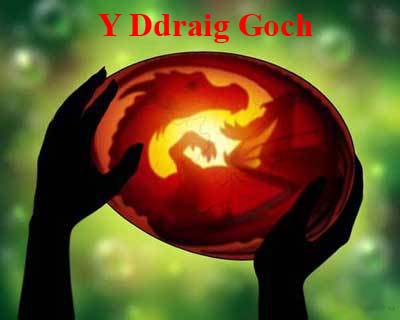
( 1) Nemeton The Sacred Grove, Copyright 20052008, Dyfed Lloyd Evans
My name is Ryan Wagner, and I'm the Associate Artistic Director of the Coeurage Theatre Company in Los Angeles. We're a brand new company in the middle of our first season right now. This summer, we'll be doing Dylan Thomas' "Under Milk Wood", and I want to make sure that we do it well. I've already read a small mountain of books and watched anything I can find on YouTube, but I'm looking to get a little more indepth.
I'm looking to dialogue with any Welsh people, in person or over Skype, who would be interested in educating an American about Welsh culture, behavior, and the many references within the text of Milk Wood. The last thing I want to do is "Americanize" the beautiful work that Dylan Thomas created, and I'll be eternally grateful for anyone who can help me out.
To anyone in Los Angeles specifically, I'd love to find a Welsh church or pub...especially if there's a rugby game on

Thank you all in advance!!
Ryan
www.coeuragetheatre.com

